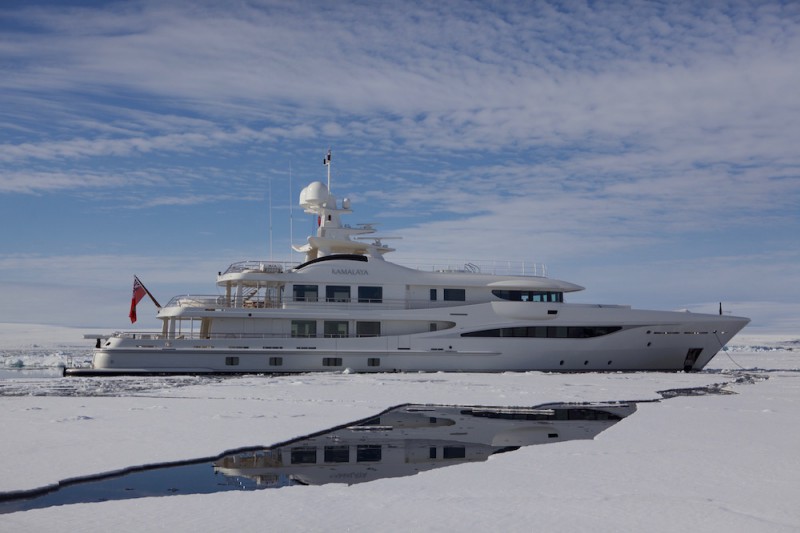Is Polar Code training sufficient for superyacht crew?
During his two Arctic cruises, Captain Christoph Schaefer of M/Y 'Kamalaya' realised the need for Polar Code training specific to yacht crew. He has since teamed up with JR Productions and Polar Safety Systems to create exactly this.…
There are a number of Polar Code training courses available. These courses are aimed at the commercial sector, though most of the syllabus of the Polar Code training is relevant for yacht crew.
The current Polar code Code training focuses on following topics:
- Ice characteristics: physics, formation, growth, ageing, ice concentrations, ice regimes, ice images, weather, movement of pack ice and icebergs, tides and currents in ice.
- Vessel characteristics: types, hulls, engineering requirements, limitations of ice class, winterisation and preparation (deck and engine), sea suction, water intake, superstructure and monitoring of ice pressure.
- Ballast monitoring, cargo operations, engine loads and cooling issues, safety procedures during ice transit.
- Antarctic Treaty and Polar Code: accident reports in polar waters
- Search and Rescue (SAR): contingency planning, survival requirements, low temperature exposure, first aid, survival techniques, awareness of common hull and equipment damage, and superstructure and deck icing, impact on stability and trim, prevention and removal of ice accretion, abandoning abandoning-ship procedures, fire fire-fighting and life life-saving appliances.
- MARPOL: sensitive areas discharge, garbage management, oil spill and ice pollution, lack of infrastructure.
- Ice navigation: hazards associated with ice, limited chart coverage, high latitude error on compasses, radar navigation, GPS limitations, communication communication-system limitations.
- Risk assessment: communication with icebreakers, ice ice-ramming procedures, different propulsion and rudder systems, safe speed in ice.
Despite the upcoming date of effect, there are still many grey areas. The concepts of the Polar Code are sound and make sense, but there is, at this moment, very little firm guidance from the IMO and the various flag states as to how the Code can be applied in the field.
One of the issues the Polar Code, in its present form, is facing, is that the region it covers is very broad, and the Arctic and Antarctic are very different from one another. Operating in the high Arctic around Svalbard, some two degrees either side of 80 degrees north, for example, is quite a different matter compared to Antarctica. Svalbard has a highly efficient and well developed search search-and- rescue (SAR) infrastructure in place, whereas in Antarctic waters, help is a long way off.
One of the issues the Polar Code, in its present form, is facing, is that the region it covers is very broad, and the Arctic and Antarctic are very different from one another.
The code Code calls for the ability of crew and passengers to survive a minimum of five days on the ice in case of abandoning ship. While in the Svalbard region the time it takes for rescuers to arrive in the Svalbard region is probably shorter than five days, severe weather can hamper SAR operationoperations, resulting in longer response times.
The remoteness of Antarctica poses even higher demands on SAR operations. On high high-capacity passenger vessels, a rescue vessel might need to be brought into position, which and this can far exceed the five-days’ minimum survival time.
Each voyage must include a risk assessment and all survival and safety equipment needs to be adopted adapted accordingly. For example, the average battery life of an EPIRB is only 48 hours. Any equipment needs to be carried in sufficient quantities to cover the entire period until rescue teams arrive on site.
Reading the Code, one could easily despair at the amount of individual and group survival equipment that needs to be carried. While the Code is certainly onerous, in reality the it is not asking to achieve the impossible. The need to carry tents, for example, is met by carrying life rafts. Life rafts come with a canopy and thus can act as a tent-like structure that gives shelter. A portable gas barbecue that can be found on most yachts can be the emergency stove needed to cook when abandoning onto on to the ice for any length of time.
As far as crew training goes, masters, chief officers and watch leaders need to be certified under the Polar Code. It is possible to have an ice pilot on board in lieu of trained officers (sometimes, depending on the region, an ice pilot is required); however, the hours of rest must be met. Essentially, this means that at least three officers on board any vessel entering the Polar seas must be Polar Code-certified, whether permanent crew aboard or hired specifically for the duration of the trip.
There are two types of Polar Code training courses: the basic (two days) and the advanced course (two two-and and-a a-half days). Masters and chief officers will have to complete both courses, and any other watch leaders will need to at least attend the basic course. At the time of writing, there are a limited number of courses available.
Image: Aaron Riegen
Profile links
Click here to become part of The Superyacht Group community, and join us in our mission to make this industry accessible to all, and prosperous for the long-term. We are offering access to the superyacht industry’s most comprehensive and longstanding archive of business-critical information, as well as a comprehensive, real-time superyacht fleet database, for just £10 per month, because we are One Industry with One Mission. Sign up here.




